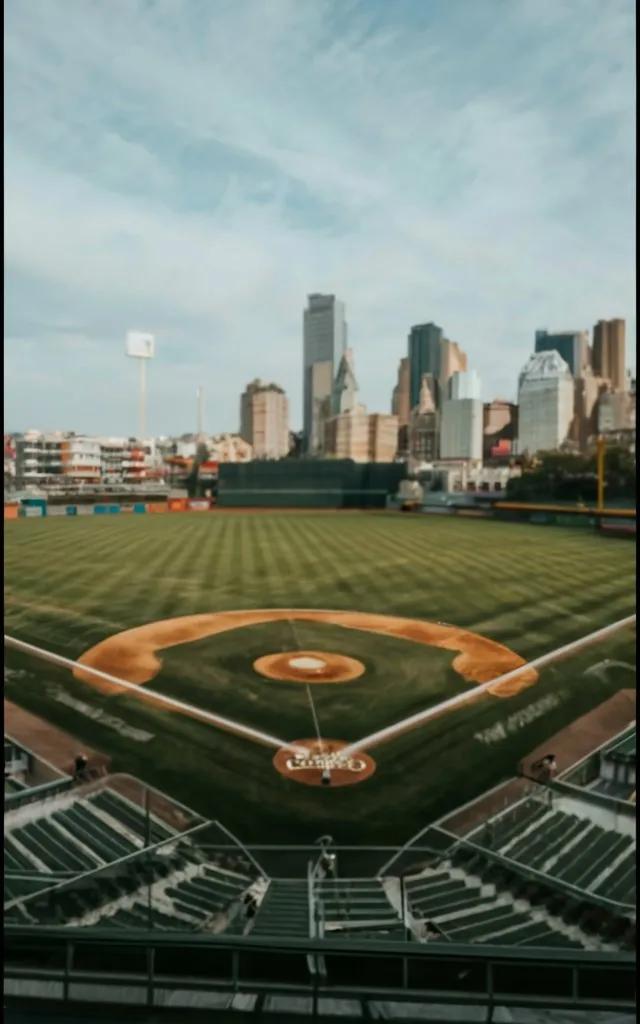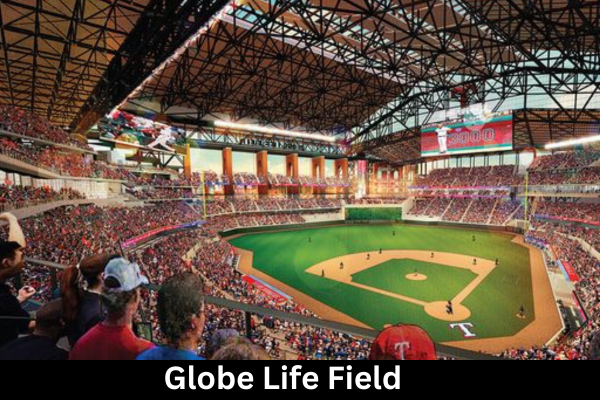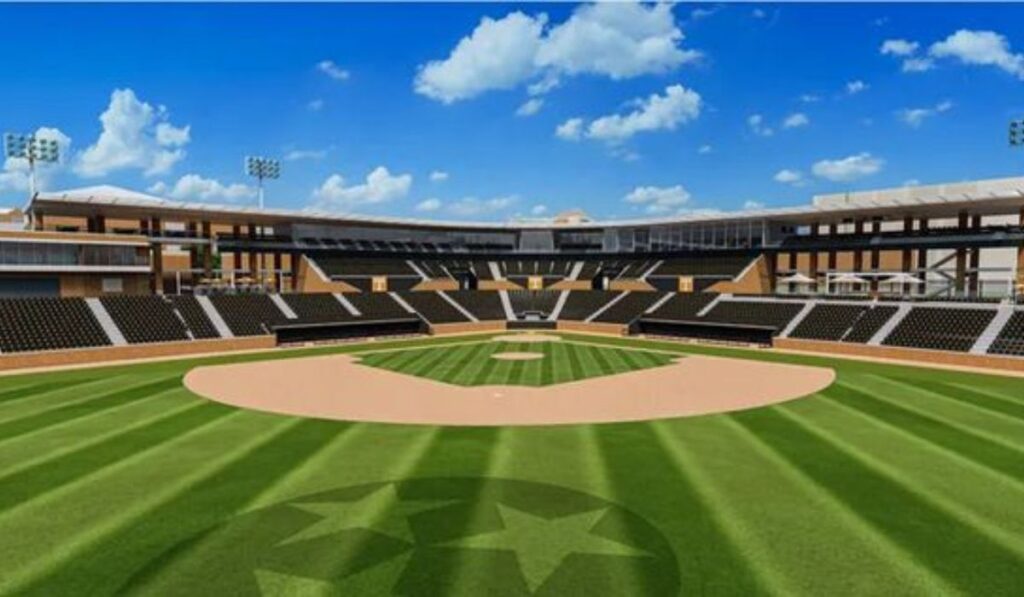
Have you ever wanted to go back in time and see how baseball began? To see the key events that make today’s game so special? Come with us on a historical journey. We’ll visit some of America’s most loved historical baseball fields.
Places like Fenway Park in Boston and Wrigley Field in Chicago are more than just stadiums. They are symbols of early Major League Baseball. These vintage baseball stadiums have lasted through the years. They still mean a lot to fans of the game.
Key Takeaways:
- Explore the rich history of America’s historical baseball fields.
- Discover the charm and nostalgia of vintage baseball stadiums.
- Experience the magic of these classic ballparks that have withstood the test of time.
- Learn about the legends and memorable moments that unfolded within their walls.
- Immerse yourself in the golden era of baseball and discover the roots of the game we know today.
The Quirky Ballparks of the Past

MLB has a rich history with unique ballparks of the past. These parks were known for quirky features like odd dimensions and high walls. They made the games more interesting and challenging.
Unforgettable Oddities
The Baker Bowl in Philadelphia stood out. It had a very high right field wall. This unusual detail turned easy popups into thrilling home run moments.
The Polo Grounds in New York had its own peculiarities. Its center field was deep, up to 505 feet. Yet, the space along the left and right field lines was short. This mix made playing there a unique challenge.
Quirks and Challenges
Players faced special difficulties in these ballparks. Batters and fielders alike had to adapt their game. Fans enjoyed the excitement and unpredictability brought by these special grounds.
These bygone ballparks were more than just venues; they were where legends were made and memorable moments happened.
As baseball moved on and new stadiums rose, many unique features faded. Yet, the memories of these quirky ballparks remain strong among fans. They remind us of the game’s colorful past and its innovative nature.
Baker Bowl: A Modern Ballpark

The Baker Bowl is a key part of baseball history, one of the first “modern” ballparks. It was rebuilt with steel and brick after a fire, becoming a cutting-edge venue. This made it the home of the Philadelphia Phillies.
Its key feature was a high right field wall. This wall was 60 feet tall, aiming to stop easy pop-ups from being home runs. It challenged players to think differently about how to hit the ball.
This right field wall was taller than Fenway Park’s famous “Green Monster.” It created more excitement and made the game harder. It helped make the Baker Bowl known as a forward-thinking ballpark.
Forbes Field: From Greenberg Gardens to Kiner’s Korner
Forbes Field was the home of the Pittsburgh Pirates. It stood out as a legendary ballpark in Major League Baseball. A key feature was its left-center field. This stretch was famous for one of MLB’s longest distances, reaching 457 feet from home plate.
The charm of Forbes Field was not just about its size. The area behind the left field fence earned the name “Greenberg Gardens.” This name came from slugger Hank Greenberg. His powerful hits often ended up in left field, thrilling fans with his awesome hitting skills.
“Greenberg Gardens will forever be remembered as a testament to the incredible talent and power of Hank Greenberg. It was a sight to behold when he stepped up to the plate and crushed one into the stands.”
After Greenberg retired, Ralph Kiner became a star for the Pirates. “Kiner’s Korner” was then named behind the left field fence in his honor. Kiner was known for his ability to hit home runs. He continued the power-hitting legacy in Forbes Field, making his own history with the Pittsburgh Pirates.
“Kiner’s Korner served as a fitting tribute to Ralph Kiner, showcasing his incredible talent and contributions to the team. It was a testament to the rich history of power hitting in Forbes Field.”
Forbes Field had many distinctive features. From its long left-center field to the famous Greenberg Gardens and Kiner’s Korner, the ballpark was truly special. This historical site remains beloved by both Pittsburgh Pirates fans and baseball lovers everywhere.
| Key Features of Forbes Field |
|---|
| Left-center field distance: 457 feet |
| Greenberg Gardens: Left field section named after Hank Greenberg |
| Kiner’s Korner: Renamed left field area in honor of Ralph Kiner |
Polo Grounds: A Tale of Two Locations

The Polo Grounds in New York was a famous stadium. It showcased a unique design seen nowhere else. It hosted the New York Giants and the New York Yankees, making a big impact on the city’s baseball history.
The stadium’s outfield caught everyone’s eye. It had a deep center field, making it hard for players to hit home runs there. This challenged the players to their limits.
But, the sides were different. The left and right fields were not as deep. This made them perfect for home runs. Players could aim down the field lines to score big.
The Polo Grounds was truly special because of this. It offered a mix of tough and welcoming areas, all in one place. Fans loved the suspense, not knowing when the next home run might come.
The Polo Grounds’ Dimensions:
| Position | Distance (feet) |
|---|---|
| Center Field | 403 – 505 |
| Left Field Line | 279 |
| Right Field Line | 258 |
The Polo Grounds had a beautifully complex playing field. With its unique design, it challenged players’ skills. It made every game thrilling, as players worked harder to score.
Tiger Stadium: Quirks and Creativity
In Detroit, Tiger Stadium stood as a classic ballpark. It was known for its unique and creative elements. These features made it stand out to both fans and players.
Notably, the right field featured an overhanging seating area. It hung 10 feet over the field, making play more interesting. Here, many home runs found their landing spot, adding thrill to the game.
The center field had a flagpole placed close to the outfield wall. This set a unique challenge for outfielders. They had to maneuver around it, enhancing the game with their skill and agility.
Despite these oddities, fans held Tiger Stadium dear. The Detroit Tigers saw this place as their true home. It was a spot where lasting memories and love for the game were shared.
Tiger Stadium: A Beloved Landmark
“I loved playing in Tiger Stadium. The overhanging seating area and the flagpole in center field gave the stadium character and made it unique. It felt like no other place in the world.” – Former Detroit Tigers player
Braves Field: A Hotbed for Home Runs
Braves Field was the home of the Boston Braves. Its center field was very deep, 550 feet from home plate. This large space made it perfect for exciting inside-the-park home runs. Players and fans loved this about it.
The center field wall was special because it had beautiful trees. These trees added to the stadium’s looks and hid the smoke from a railyard. It was a clever design that made Braves Field unique.
The tree-lined wall of Braves Field
Braves Field’s unique features made it memorable for everyone. The long distance to center field and the wall of trees set it apart. It offered both challenges and delights to the game.
Notable Moments in Braves Field
- 1921: Braves outfielder Dave Bancroft hits an inside-the-park grand slam during a game against the St. Louis Cardinals.
- 1929: Babe Ruth of the New York Yankees wows the crowd with a mammoth 550-foot home run to center field.
- 1940: Boston Braves pitcher Jim Tobin becomes the first pitcher in history to hit three home runs in a single game, all at Braves Field.
Braves Field is a special place in baseball history. It marks an era of big home runs and beautiful surroundings. Even though new stadiums have come, its memory remains in the hearts of fans.
Municipal Stadium: The Mistake by the Lake
Municipal Stadium in Cleveland earned the name “The Mistake by the Lake.” It was known for its huge size that made playing baseball there tough.
Center field was a huge 470 feet from home plate. This distance made hitting a home run very hard. The size of the field challenged players to hit the ball far.
The left and right field corners were not much shorter, at 463 feet. This big open space made it hard to score a home run. As a result, the stadium was great for pitchers and fielders.
The Cleveland Indians made a smart move to help them win. They put in adjustable fences in right field. This let them change the field to help themselves depending on the game.
Municipal Stadium was a place where great baseball moments happened. Even with the big challenge, some of the best players in baseball history played there. Fans were always excited because of the unique play the stadium encouraged.
Dimensions of Municipal Stadium
| Area | Distance (in feet) |
|---|---|
| Center Field | 470 |
| Left and Right Field Corners | 463 |
The vast dimensions of Municipal Stadium created a challenging playing environment for the Cleveland Indians.
The Astrodome: The Eighth Wonder of the World
The Astrodome in Houston was dubbed the “Eighth Wonder of the World.” It changed sports stadiums forever when it opened in 1965. It was the first enclosed, multipurpose, and air-conditioned sports venue. This marked a new era in stadium design and comfort.
It featured a retractable roof, a groundbreaking element. This roof could open and close, letting events happen no matter the weather. People were amazed by the action of the roof, making the Astrodome stand out from other stadiums.
Interestingly, if a ball hit the roof or the speakers above the field, it was still in play. This rule brought a fun and unexpected vibe to the games, leading to some unique moments.
The Astrodome’s lighting was also like no other. The special system aimed to keep shadows off the field. It not only helped players see better but also created a magical atmosphere.
Moreover, the Astrodome introduced AstroTurf – artificial grass. This advance meant games could happen on a consistent field, no matter the weather. It also saved on maintenance costs for the stadium.
The Astrodome’s indoor setting with a retractable roof was a model for the future. It influenced the design and comfort of stadiums worldwide. Its influence is seen in many sports venues today.
Conclusion


Exploring America’s historical baseball fields takes us back in time. It shows the start of our beloved sport. Places like Wrigley Field and the Baker Bowl are more than old ballparks. They’re part of baseball’s heart.
Whether it’s the ivy at Wrigley Field or the Baker Bowl’s big wall, each spot has a special tale. They are a joy for fans. These famous places have seen amazing moments. They’ve made fans smile and cheer for years.
So, grab your baseball cap and visit these old baseball fields. Feel the history and joy of these places. They carry the game’s past with grace. Discover the wonder of these fields. Here, the game’s true spirit lives on.
Recommended
- BASEBALL FLOW HAIRCUT: TRENDY STYLES FOR ATHLETES
- WHY ARE BASEBALL BATS SO EXPENSIVE? UNRAVELING COST
- REGRIP BASEBALL BAT: EASY STEPS FOR BETTER PERFORMANCE

Meet Daniel Anderson, the heart and soul behind Baseball Pro Picks. At 49, Daniel’s life has revolved around baseball, a passion that’s as strong today as it was when he first fell in love with the game. Living in the USA, Daniel has dedicated countless hours to watching, analyzing, and understanding every pitch, hit, and home run, making almost no game missed. His deep-rooted love for the sport is matched only by his commitment to sharing insightful, expert analysis with fellow baseball enthusiasts. With decades of experience and a keen eye for the game’s nuances, Daniel brings a unique perspective that enriches Baseball Pro Picks. Trust Daniel to guide you through the intricacies of baseball with the authority and trustworthiness of a true aficionado.












